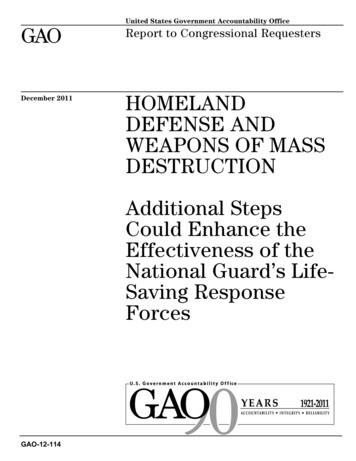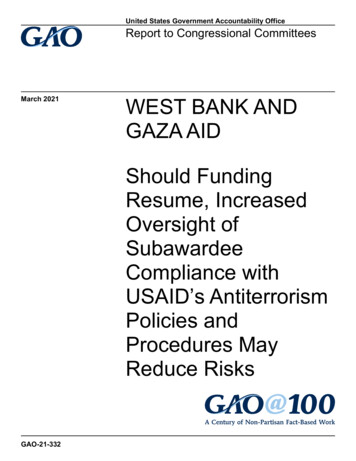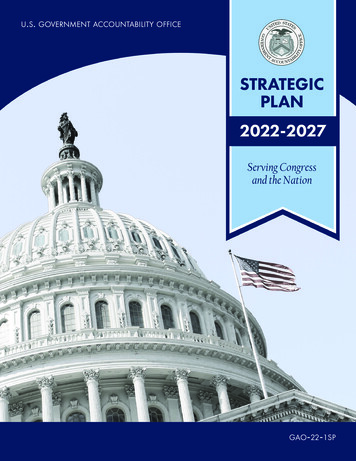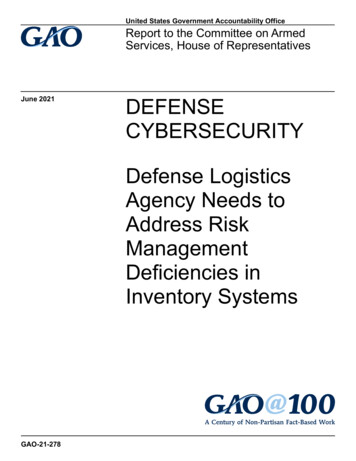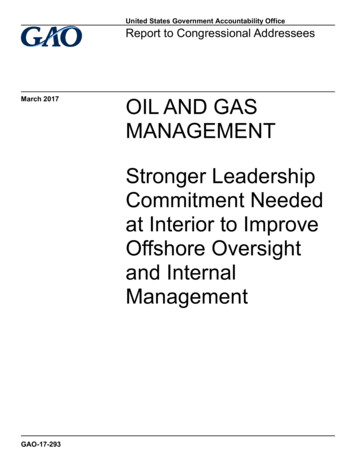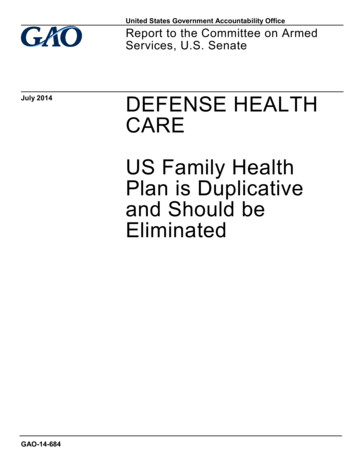
Transcription
United States Government Accountability OfficeReport to the Committee on ArmedServices, U.S. SenateJuly 2014DEFENSE HEALTHCAREUS Family HealthPlan is Duplicativeand Should beEliminatedGAO-14-684
July 2014DEFENSE HEALTH CAREUS Family Health Plan is Duplicative and Should beEliminatedHighlights of GAO-14-684, a report to theCommittee on Armed Services, U.S. SenateWhy GAO Did This StudyWhat GAO FoundDOD provides health care to about9.6 million eligible beneficiariesthrough its TRICARE program. Thedepartment contracts with MCSCs toadminister TRICARE’s benefit optionsin three regions across the UnitedStates. Separately, DOD contracts withsix USFHP designated providers tooffer TRICARE Prime—the managedcare option—to enrollees in certainlocations across the country.The role of the US Family Health Plan (USFHP) within the Department ofDefense’s (DOD) current military health system (MHS) is duplicative because itoffers military beneficiaries the same TRICARE Prime benefit that is offered bythe regional TRICARE managed care support contractors (MCSC). The USFHPis an association of six health care providers, referred to as designated providers,which took ownership and control of U.S. Public Health Service hospitals in 1982when Congress enacted legislation that made these facilities part of DOD’shealth care system. During the implementation of TRICARE in the 1990s,Congress required the designated providers to offer the TRICARE Prime benefitto their enrollees. While the USFHP is a relatively small program—approximately134,000 enrollees—there is significant overlap with the MCSCs in several keyareas, including benefits, geographic service areas, and provider networks. Forexample, four of the six USFHP designated providers have more than 80 percentof their service area zip codes included in areas where the MCSCs offerTRICARE Prime. Furthermore, the USFHP remains a distinct statutory programthat is not integrated with the rest of the MHS. This limits DOD’s ability toincrease efficiency by maximizing the use of its direct care system of militarytreatment facilities (MTF), which USFHP enrollees are generally precluded fromusing because the USFHP’s payment structure is intended to cover all enrollees’health care costs. The role of the USFHP has not been reassessed sinceTRICARE was implemented in the 1990s. However, DOD officials told us thatthere is not a function that the USFHP designated providers serve that theMCSCs could not perform. Furthermore, officials from all three MCSCs—whichtogether serve over 4.5 million Prime enrollees—said that they would likely havethe capacity and capability to provide TRICARE coverage to all current USFHPenrollees, if needed.Senate Report 112-173, whichaccompanied a version of the NationalDefense Authorization Act for FiscalYear 2013, mandated that GAO reviewDOD’s health care contracts, citingconcerns with the growing costs ofthese contracts, including the USFHP.For this report, GAO examined (1) therole of the USFHP within the MHS, and(2) the extent to which the USFHPaffects DOD’s health care costs. GAOanalyzed information about the USFHPand the MCSCs, reviewed availableUSFHP cost data, and interviewedofficials from DOD, the designatedproviders, and the MCSCs.What GAO RecommendsCongress should terminate DOD’sauthority to contract with the USFHPdesignated providers in a mannerconsistent with a reasonable transitionof affected USFHP enrollees intoTRICARE’s regional managed careprogram or other health care programsas appropriate. DOD confirmed thatGAO’s factual determinations aboutthe USFHP are correct and agreed thatthis program is duplicative and resultsin unnecessary costs and otherinefficiencies. DOD reiterated theimportance of carefully transitioningUSFHP enrollees to other health plansif the USFHP were eliminated.View GAO-14-684. For more information,contact Debra A. Draper at (202) 512-7114 ordraperd@gao.gov.Because the USFHP’s role of offering TRICARE Prime is duplicative of the roleof the MCSCs, DOD has incurred added costs and inefficiencies. Although DODwould incur health care costs for the USFHP enrollees regardless of with whomthey are enrolled, DOD pays administrative costs and profits to two differentgroups of contractors for providing the same TRICARE Prime benefit to the samepopulation of eligible beneficiaries in many of the same areas. However, outsideof the negotiated payment amounts, no one knows the designated providers’actual costs for administering the program since the USFHP contracts arecharacterized in statute as commercial item contracts. This means that thedesignated providers are exempt from sharing certified cost or pricing data withDOD, and they have been unwilling to share uncertified cost or pricing data whenrequested. As a result, DOD does not know how much of the approximately 1.1 billion it pays the USFHP designated providers annually actually goestoward their administrative costs and profit versus the cost of health careservices. DOD also incurs other expenses for the USFHP through supportcontracts, including a 21 million data support contract, and through themanagement of various aspects of the program. Eliminating this statutorilyrequired program would not only eliminate unnecessary costs and inefficiencies,but would also free up departmental resources that could be better used tomanage other aspects of the TRICARE program.United States Government Accountability Office
ContentsLetter1BackgroundThe USFHP Duplicates the Role of the MCSCs in offering theTRICARE Prime Option and is not Integrated with the Rest ofthe MHSThe USFHP’s Duplicative Role Results in Added Costs andInefficiencies for DODConclusionsMatter for Congressional ConsiderationAgency CommentsAppendix IPast and Current US Family Health Plan (USFHP) DesignatedProviders5101721212224Appendix IIUS Family Health Plan (USFHP) Designated Provider Characteristics 25Appendix IIIDiscounts and Services Offered by Designated Providers in Additionto the TRICARE Prime Benefit as of June 201426Appendix IVComments from the Department of Defense27Appendix VGAO Contact and Staff Acknowledgments30Table 1: Percent of US Family Health Plan (USFHP) Service AreaZip Codes That Overlap with the TRICARE ManagedCare Support Contractors’ (MCSC) Prime Service AreaZip CodesTable 2: Percent of US Family Health Plan (USFHP) ProvidersAlso Participating in Managed Care Support Contractors’(MCSC) Provider Networks11TablesPage i13GAO-14-684 US Family Health Plan
FiguresFigure 1: Location of Six US Family Health Plan (USFHP)Designated Providers within the Three TRICARERegionsFigure 2: US Family Health Plan (USFHP) Enrollees as a Percentof Total TRICARE Prime Enrollees, and by DesignatedProvider as of October ment of DefenseFederal Acquisition RegulationManaged Care Support ContractorMilitary Health SystemMilitary Treatment FacilityNational Defense Authorization ActUS Family Health PlanThis is a work of the U.S. government and is not subject to copyright protection in theUnited States. The published product may be reproduced and distributed in its entiretywithout further permission from GAO. However, because this work may containcopyrighted images or other material, permission from the copyright holder may benecessary if you wish to reproduce this material separately.Page iiGAO-14-684 US Family Health Plan
441 G St. N.W.Washington, DC 20548July 31, 2014The Honorable Carl LevinChairmanThe Honorable James InhofeRanking MemberCommittee on Armed ServicesUnited States SenateThe Department of Defense (DOD) offered health care coverage to about9.6 million eligible beneficiaries through TRICARE, its regionallystructured health care program, at a cost of almost 50 billion in fiscalyear 2013. 1 TRICARE consists of a direct care system of militarytreatment facilities (MTF) and a purchased care system of civilian healthcare providers that is used to augment the direct care system whenneeded. For each TRICARE region in the United States, DOD’s DefenseHealth Agency, which oversees the program, contracts with private sectorcompanies—referred to as managed care support contractors (MCSC)—to administer TRICARE’s benefit options, including TRICARE Prime, itsmanaged care option. 2 Specifically, the MCSCs are responsible fordeveloping and maintaining civilian provider networks and providing otherservices, such as enrollment, specialty care referrals, medical casemanagement, claims processing, and customer service. Separately, incertain locations, TRICARE Prime is also offered by the US Family HealthPlan (USFHP), an association of six health care providers—referred to asdesignated providers—located throughout the country. The USFHP is astatutorily required component of the Military Health System (MHS) thatoffers the TRICARE Prime option to about 134,000 active dutydependents and retirees and their dependents at a cost of over 1 billion1TRICARE-eligible beneficiaries include active duty personnel and their dependents,medically eligible Reserve and National Guard personnel and their dependents, andretirees and their dependents and survivors.2Prior to October 1, 2013, the TRICARE Management Activity, an entity within DOD, wasresponsible for overseeing the TRICARE program. In response to increasing pressure onits budgetary resources, DOD established the Defense Health Agency on October 1,2013, to assume management responsibility of numerous functions of its medical healthsystem, including the former TRICARE Management Activity, which was terminated onthat date. For additional information, see GAO, Defense Health Care Reform: AdditionalImplementation Details Would Increase Transparency of DOD’s Plans and EnhanceAccountability, GAO-14-49 (Washington, D.C: Nov. 6, 2013).Page 1GAO-14-684 US Family Health Plan
in fiscal year 2013. 3 The USFHP was initially incorporated into the MHS in1982 when Congress enacted legislation transferring ownership of certainU.S. Public Health Service hospitals to the designated providers. 4 Thisarrangement guaranteed the designated providers a stable revenuesource by enabling them to provide care to military beneficiaries inaddition to their private health care business, while also improvingbeneficiaries’ access to care in the areas served by the designatedproviders. During the implementation of the TRICARE program in the1990s, Congress required the designated providers to offer the TRICAREPrime benefit to their enrollees in accordance with the National DefenseAuthorization Act (NDAA) for Fiscal Year 1997. 5 Today, the USFHPremains a health care option required by statute to be available to eligiblebeneficiaries in certain locations, despite TRICARE’s national presencethrough the MCSCs.As health care consumes an increasingly large portion of the overallDefense budget—the Congressional Budget Office reported in 2011 thatDOD’s health care costs are projected to reach nearly 92 billion by2030—it is important for DOD to operate its health care system efficiently,while also ensuring high-quality care. 6 DOD leadership has also recentlyacknowledged the need to reduce duplication and overhead, operate itshealth system as efficiently as possible, and realize savings in the MHS. 7However, as the TRICARE program has matured and the cost of healthcare has increased, the USFHP has largely remained unchanged sincethe NDAA for Fiscal Year 1997, and its role has not been reassessed3All beneficiaries who are eligible for DOD health care and who are under the age of 65,except active duty servicemembers, are eligible for USFHP enrollment. However, eachyear the number of USFHP enrollees may not exceed 110 percent of the previous year’senrollee population. See National Defense Authorization Act (NDAA) for Fiscal Year 1997,Pub. L. No. 104-201, § 724(b), 110 Stat. 2422, 2595 (1996) (codified at 10 U.S.C. § 1073note). In this report, future citations to the NDAA for Fiscal Year 1997 will identify theapplicable section of law without providing a full citation, as set forth here.4The Military Construction Authorization Act, 1982 deemed these facilities to be facilitiesof the uniformed services, then known as Uniformed Services Treatment Facilities. SeePub. L. No. 97-99, § 911, 95 Stat. 1359, 1386 (1981).5NDAA for Fiscal Year 1997, § 723(a).6Congressional Budget Office, Long-term Implications of the 2012 Future Years DefenseProgram, Pub. No. 4281 (Washington, D.C.: June 2011). These numbers are reported innominal dollars and have not been adjusted for inflation.7See GAO-14-49.Page 2GAO-14-684 US Family Health Plan
within the current MHS. Senate Report 112-173, which accompanied theSenate Committee on Armed Services’ version of the NDAA for FiscalYear 2013, mandated that GAO conduct a comprehensive review ofDOD’s health care contracts, and identify opportunities for potentialsavings and efficiencies. 8 In this report, we examine (1) the role of theUSFHP within the MHS, and (2) the extent to which the USFHP affectsDOD’s health care costs.To examine the role of the USFHP within the MHS, we reviewedrequirements relevant to the USFHP and the TRICARE program,including those established in federal laws and regulations, contracts,policy manuals, and benefit handbooks. 9 We interviewed DOD officials,including officials from DOD’s Defense Health Agency; officials at each ofthe TRICARE Regional Offices (North, South, and West); Army, Navy,and Air Force regional officials; and officials at MTFs located withinUSFHP service areas to discuss the role of the USFHP and its impact onthe regional TRICARE program, including DOD’s direct care system. Wealso reviewed DOD’s reports on its TRICARE program. In addition, weinterviewed officials from the six USFHP designated providers, theUSFHP Alliance, and the three regional MCSCs, and obtained andanalyzed information about their operations, including information abouttheir TRICARE Prime benefits, enrollees, geographic service areas, andprovider networks. 10 We reviewed and applied GAO’s framework foraddressing fragmentation, overlap, and duplication to assess the extent towhich the USFHP and TRICARE MCSCs engaged in the same activitiesor strategies to provide the same services to the same target recipients orindividuals. 11 We also interviewed officials from beneficiary interest8S. Rep. No. 112-173, at 131-132 (2012). For our work on TRICARE pharmacy servicecontracts, see GAO, Defense Health Care: Evaluation of TRICARE Pharmacy ServicesContract Structure Is Warranted, GAO-13-808 (Washington, D.C.: September 2013). Forour work on TRICARE managed care support contracts, see GAO, Defense Health Care:Acquisition Process for TRICARE’s Third Generation of Managed Care Support Contracts,GAO-14-195 (Washington, D.C.: March 2014). For our work on TRICARE dental servicescontracts, see GAO, Defense Health Care: TRICARE Dental Services Contracts’Requirements and Structure, GAO-14-497 (Washington, D.C.: June 2014).9We did not assess the department’s compliance with the program’s requirements.10The USFHP Alliance is the association that represents the interests of the sixdesignated providers in interactions with DOD and Congress.11See GAO, 2014 Annual Report: Additional Opportunities to Reduce Fragmentation,Overlap, and Duplication and Achieve Other Financial Benefits, GAO-14-343SP(Washington, D.C.: April 8, 2014).Page 3GAO-14-684 US Family Health Plan
groups to obtain their perspective about the USFHP. We did not assessthe quality of the care or benefits offered by either the USFHP designatedproviders or the MCSCs.To examine the extent to which the USFHP affects DOD’s health carecosts, we obtained and reviewed USFHP cost information, including thecosts of the designated provider contracts and other DOD contractsrelated to the administration of the program. To better understand therequirements related to the USFHP’s costs, we reviewed relevant federallaws and regulations, including laws pertaining to the USFHP and theFederal Acquisition Regulation (FAR). 12 We interviewed DOD officials andofficials from DOD’s actuarial contractor to obtain information about thecosts of the USFHP and how these costs have changed over time.Additionally, we asked DOD’s contractor to provide us with a breakdownof the average capitation payments paid to the designated providers forfiscal year 2013, which includes amounts that have been allocated tocover the costs of health care services for USFHP enrollees, as well asthe administrative costs and profit margins for the designated providers. 13Additionally, we obtained information from DOD officials and its actuarialcontractor about DOD’s annual process for developing its capitationpayment rates for the designated providers, the components of thesepayments, and challenges related to determining how much thesepayment rates reflect actual health care costs. We obtained informationfrom DOD’s contractor about the reliability of the data on the capitationpayment rates, and we determined that these data were sufficientlyreliable for the purposes of our report. Finally, we obtained informationabout the USFHP acquisition process and DOD’s annual process fornegotiating the designated provider capitation payments to identifyresources related to these efforts.We conducted this performance audit from March 2013 to July 2014 inaccordance with generally accepted government auditing standards.Those standards require that we plan and perform the audit to obtainsufficient, appropriate evidence to provide a reasonable basis for ourfindings and conclusions based on our audit objectives. We believe that12The FAR defines uniform policies for the acquisition of supplies and services across thefederal government. The FAR is codified in title 48 of the Code of Federal Regulations.13Under capitation payments, health care plans are prospectively paid a fixed monthly rateper enrollee to provide or arrange for most health care services.Page 4GAO-14-684 US Family Health Plan
the evidence obtained provides a reasonable basis for our findings andconclusions based on our audit objectives.BackgroundOverview of the USFHPThe USFHP is a statutorily required component of the MHS that offers theTRICARE Prime option to eligible military beneficiaries through 6designated providers in certain locations across the country. 14 Over theyears, the number of designated providers has dropped from 10 to 6. The6 USFHP designated providers that currently administer the USFHP are:(1) Johns Hopkins Medical Services Co., (2) Brighton Marine HealthCenter, (3) Martin’s Point Health Care, (4) CHRISTUS Health, (5) PacificMedical Centers, and (6) St. Vincents Catholic Medical Centers. (Seeappendix I for a comparison of USFHP designated providers in 1994 and2014.) The reduction in designated providers has largely been due toprovider consolidations. 15 In one case, a designated provider opted to nolonger participate in the program. 16 According to DOD officials, USFHPenrollees for that designated provider were successfully transitioned toother health care programs for which they were eligible, including theTRICARE options administered by the TRICARE MCSC in that region.Some of the designated providers provide care exclusively tobeneficiaries enrolled in the USFHP, while others also provide health careservices to beneficiaries of other health plans and may have additionallines of business. (See appendix II for more information on thecharacteristics of each of the designated providers.) Each of thedesignated providers—and their respective service areas—are locatedwithin one of the three TRICARE regions in the United States. Figure 1below illustrates the location of the USFHP designated providers relativeto the locations of the three TRICARE regions.14See NDAA for Fiscal Year 1997, §§ 721-727.15Specifically over the years, some hospitals that were formerly separate designatedproviders were consolidated under CHRISTUS Health.16One former designated provider, Lutheran Medical Center, merged with FairviewHospital in 1995 and in 1997 became part of the Cleveland Clinic Health System. DODofficials told us that this designated provider decided to end its USFHP contract with thedepartment in 2007.Page 5GAO-14-684 US Family Health Plan
Figure 1: Location of Six US Family Health Plan (USFHP) Designated Providers within the Three TRICARE RegionsNote: TRICARE is organized in three regions across the United States—North, South, and West.Within these regions, the Department of Defense contracts with managed care support contractors todevelop provider networks and to administer TRICARE’s benefit options. Alaska and Hawaii arelocated in TRICARE’s West region.The six designated providers offer TRICARE Prime to eligiblebeneficiaries through civilian provider networks in their service areas. Toreceive care through the USFHP, eligible beneficiaries must enroll in theprogram. All beneficiaries eligible for DOD health care and who are underthe age of 65, except active duty servicemembers, are eligible for USFHPPage 6GAO-14-684 US Family Health Plan
enrollment. 17 Beneficiaries who live in a location served by one of the sixdesignated providers may elect to enroll in TRICARE Prime with theUSFHP instead of enrolling with the MCSC. As of October 2013,approximately 134,000 beneficiaries were enrolled in the USFHP—about3 percent of all TRICARE Prime enrollees. See figure 2 for the totalnumber of USFHP enrollees as a percent of total TRICARE Primeenrollees, as also delineated by designated provider.Figure 2: US Family Health Plan (USFHP) Enrollees as a Percent of Total TRICARE Prime Enrollees, and by DesignatedProvider as of October 2013aTRICARE Prime includes enrollees in Prime (military and civilian primary care managers), TRICAREPrime Remote, TRICARE Young Adult Prime, and US Family Health Plan; and excludes beneficiariesin TRICARE For Life, TRICARE Plus, TRICARE Young Adult Standard, and TRICARE Reserve17Previously, all Medicare-eligible individuals aged 65 and older were also allowed toenroll in the USFHP. The NDAA for Fiscal Year 2012 amended the law, requiringbeneficiaries enrolling in USFHP after September 30, 2012 to discontinue their USFHPcoverage and transition to TRICARE For Life once they reach 65 years of age.Beneficiaries enrolled with a USFHP designated provider on September 30, 2012 did nothave to discontinue their USFHP coverage after reaching 65 years of age. Pub. L.No. 112-81, § 708, 125 Stat. 1298, 1474 (2011), amending section 724(e) of the NDAA forFiscal Year 1997.Page 7GAO-14-684 US Family Health Plan
Select. The total number of TRICARE Prime enrollees excludes Prime enrollees located outside ofthe United States.The NDAA for Fiscal Year 1997 mandated a number of key aspects of theUSFHP. For example, the statute prohibits DOD from reducing the size ofa designated provider’s geographic service area below the size in effectas of September 30, 1996. 18 However, DOD does have discretion toincrease the size of a designated provider’s service area. In addition,DOD is required to enter into sole-source contracts with the designatedproviders to administer the USFHP. 19 The statute also requires thesecontracts to be treated as commercial item contracts under the FAR—adesignation that prohibits DOD from requiring the designated providers toprovide certified cost or pricing data during contract negotiations. 20Additionally, the statute mandates that annual payments to thedesignated providers are to be made on a full-risk capitation paymentbasis, 21 which means that the designated providers are fully at-risk for thecost of beneficiaries’ health care services. These payments cover theprojected costs of all the medical care an enrollee needs for the year plusadministrative costs and profit. DOD and each of the designatedproviders annually negotiate the amounts of their capitation payments,which represent projected costs based on estimates and adjustments forfactors such as differences in health care costs by geographic area andenrollees’ health status. 22 The statute limits total capitation payments tothe designated providers, which cannot exceed the cost that would havebeen incurred by the government if USFHP enrollees had received theircare through Medicare or TRICARE, including its direct care system of18NDAA for Fiscal Year 1997, § 722(e).19NDAA for Fiscal Year 1997, § 722(b)(2).20See NDAA for Fiscal Year 1997, § 722(b)(2). Offerors competing for commercial itemcontracts may not be required to provide certified cost or pricing data during contractnegotiations. FAR § 15.403-1(b)(3). Section 2.101 of the FAR defines cost or pricing dataas all facts that buyers and sellers would reasonably expect to affect price negotiations. Inacquisitions where certified cost or pricing data are required, section 15.406-2 of the FARprovides that contractors must certify that required cost or pricing data are accurate,complete, and current as of a specified date.21NDAA for Fiscal Year 1997, § 726(a).22The final rates are the results of negotiations involving two rates: (1) rates that areproposed by the designated providers, and (2) rates that are proposed by DOD.Page 8GAO-14-684 US Family Health Plan
MTFs or its purchased care system of civilian providers. 23 The USFHPcontracts are expected to cost approximately 6.4 billion over 5 years.Overview of TRICAREIn 1993, DOD reformed the MHS by implementing TRICARE, anationwide managed health care program designed to improve accessand ensure high-quality health care while also addressing DOD’s risinghealth care costs. TRICARE consists of a direct care system of MTFs anda purchased care system of civilian health care providers that are used toaugment the direct care system when needed. TRICARE offers threebasic benefits to eligible beneficiaries: TRICARE Prime (a managed careoption), TRICARE Extra (a preferred provider option), and TRICAREStandard (a fee-for-service option). In addition, DOD administers otherTRICARE benefits, such as TRICARE For Life, which is secondarycoverage to Medicare for all beneficiaries who have both MedicareParts A and B.DOD’s Defense Health Agency uses MCSCs to administer TRICARE’sbenefit options in three regions across the United States—North, South,and West. Within these regions, MCSCs are required to develop providernetworks and offer the TRICARE Prime option in geographic areas calledPrime Service Areas. 24 DOD requires MCSCs to establish Prime ServiceAreas around MTFs and Base Realignment and Closure sites to augmentthe capability and capacity of MTFs with a civilian provider network. 25Beneficiaries living in Prime Service Areas can choose between theTRICARE Prime, TRICARE Standard, and TRICARE Extra options. 26Beneficiaries who choose TRICARE Prime—the managed care option—must enroll. The MCSCs are responsible for assigning Prime enrollees toPrimary Care Managers, who provide or arrange for all health care23NDAA for Fiscal Year 1997, § 726(b).24Prime Service Areas have been established in zip codes that are within a 40 mile radiusof an MTF or Base Realignment and Closure site. As of October 1, 2013, DOD eliminatedthe additional Prime Service Areas that were not near MTFs or Base Realignment andClosure sites in an effort to reduce health care costs. This change affected approximately181,600 beneficiaries previously eligible for the TRICARE Prime option.25Base Realignment and Closure sites are military installations that have been closed orrealigned as a result of decisions made by the Commission on Base Realignment andClosure.26TRICARE also offers several other plans, including TRICARE Young Adult-StandardOption (for beneficiaries’ dependents up to age 26) and TRICARE Reserve Select (forcertain National Guard and Reserve servicemembers).Page 9GAO-14-684 US Family Health Plan
services required by their enrollees. Beneficiaries who live outside ofPrime Service Areas can choose between the TRICARE Standard andTRICARE Extra options.Unlike the USFHP contracts, the TRICARE managed care supportcontracts are awarded on a competitive basis. Further, DOD reimbursesthe MCSCs for the cost of health care services provided to TRICAREbeneficiaries. As a result, the MCSCs are not “at risk” for theirbeneficiaries’ health care costs as are the designated providers underUSFHP. As of fiscal year 2012, the TRICARE managed care supportcontracts comprised DOD’s three largest purchased care contracts. Thecosts of these three contracts are expected to total approximately 56 billion over their 5-year performance period.The USFHPDuplicates the Role ofthe MCSCs in offeringthe TRICARE PrimeOption and is notIntegrated with theRest of the MHSThe USFHP’s role within the current MHS is duplicative because it offersmilitary beneficiaries the same TRICARE Prime benefit that is offered bythe MCSCs across much of the same geographic service areas andthrough many of the same providers. Furthermore, the USFHP is notintegrated with the rest of the MHS, and does not support DOD’s effortsto increase efficiency because it potentially diverts enrollees away fromDOD’s direct care system.The USFHP’s Role withinthe MHS is DuplicativeThe USFHP’s role in offering TRICARE Prime within the context of thecurrent MHS duplicates the role of the MCSCs in several importantways. 27 For example, the USFHP designated providers and the MCSCsboth offer the same TRICARE Prime benefit as required by law. 28 DODimplements this uniform benefit requirement by incorporating the27We have previously defined duplication as a situation where two or more programs areengaged in the same activities or strategies to meet a need, or provide the same servicesto the same target recipients or individuals. See GAO-14-343SP.28Specifically, section 723(a) of the NDAA for Fiscal Year 1997 requires designatedproviders to offer enrollees the health benefit option prescribed by section 731 of theNDAA for Fiscal Year 1994. This refers to the TRICARE Prime benefit option applicable toMCSCs, which is to be as unifor
the regional TRICARE managed care support contractors (MCSC). The USFHP is an association of six health care providers, referred to as designated providers, which took ownership and control of U.S. Public Health Service hospitals in 1982 when Congress enacted legislation that made these facilities part of DOD's health care system.



